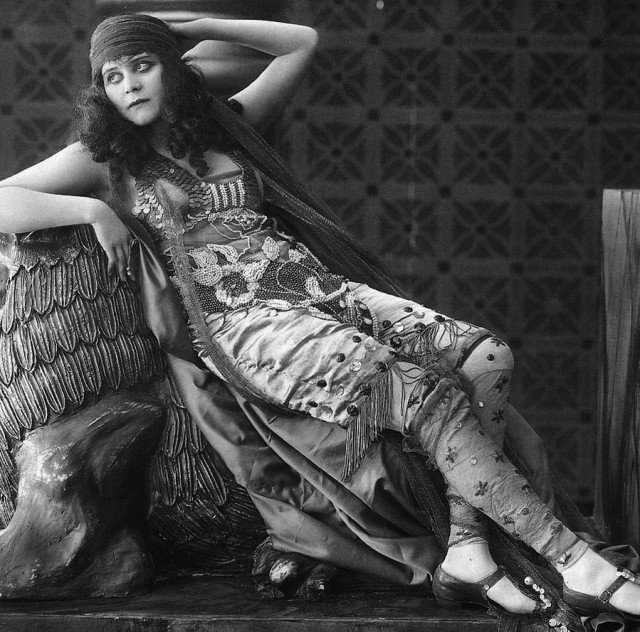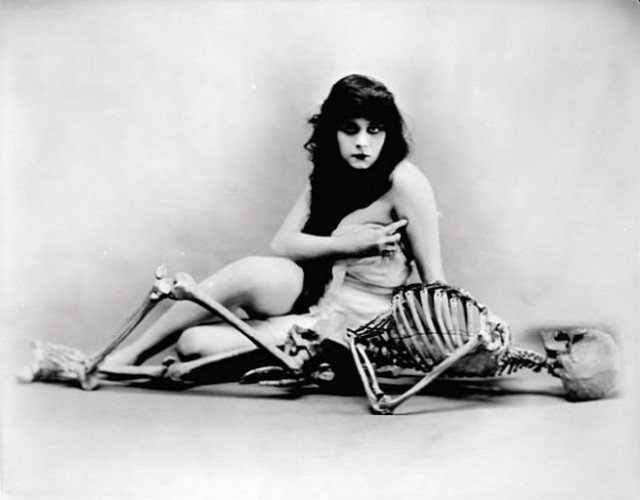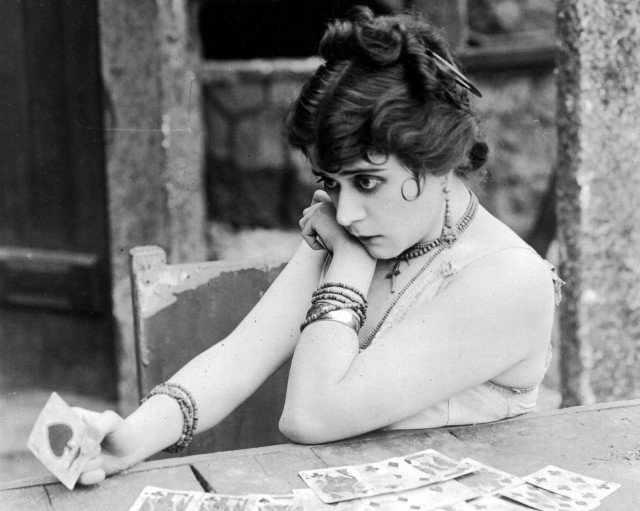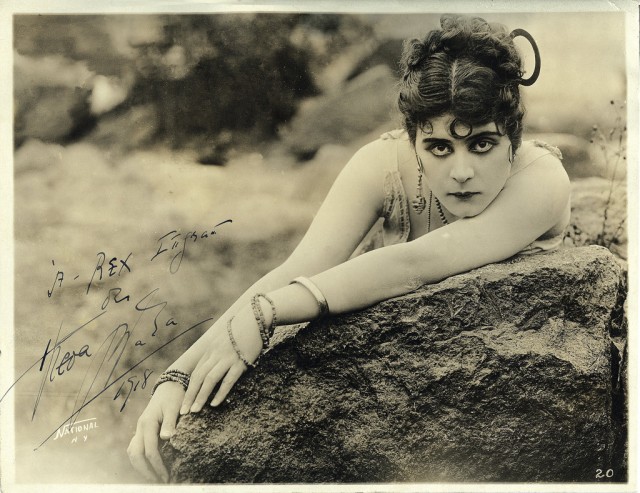Scandals of Classic Hollywood: The Most Wicked Face of Theda Bara
by Anne Helen Petersen

Theodosia Goodman grew up in Cincinnati, the child of middle-class Jewish immigrants. Her father was a tailor; her mother kept house. She went to high school, she went to two years of college. She was a middling actress with middling looks, age 30, stuck in the Yiddish theater circuit, with a bit role in the occasional film. She was wholly unremarkable — one of hundreds of women working toward the same end.
And then, in 1915, totally out of nowhere, she became THE BIGGEST SEX SYMBOL IN THE WORLD. As the star of A Fool There Was, she embodied the cinematic “vamp” — the evil, predatory woman who seduces men with her dark ways, sucks him dry, and leaves him for ruin. Her name was no longer Theodosia Goodman, but Theda Bara — an anagram, naturally, for “ARAB DEATH.” Her mother was a French actress, her father was an Italian sculptor, yet she had been born “in the shadow of the Sphinx.” She dabbled in the Occult; she communed with dark spirits. She had been reincarnated several times and lunched on lettuce and raw beef. Girl even became her own verb: to pull a “ThedaBara” was to “seduce and destroy.” Offscreen, Bara was her cinematic character made flesh: an alluring, vampish creature, occupying the liminal space between this world and the next. Put differently, Bara was the most blatantly absurd and exquisite of the silent0-era studios’ creations.
Bara’s extravagant image was the source of her fame, but it likewise shackled her to a very specific set of behaviors — and ways of appearing in public and on the screen. And like all star images, its potency, and its particular social resonance, faded with time. By 1920, Bara’s career was effectively over, and today, only one of her major films remains intact. But for a brief moment in cinematic history, her image functioned as a volatile conduit for displaced female desire. Bara’s image was the immaculate conflation of sex and evil, and in an era still governed by rigid codes of moral, spiritual, and social behavior, it was absolutely irresistible.

But let’s be clear: This image was unlike any publicity concoction we’ve ever seen. Sure, Hollywood regularly erased stars’ histories, but rarely as boldly, and with such little concern for credibility, as it did with Bara’s. Fox didn’t just give Bara a new name or a new ethnicity, it made her a creature of the underworld. Sure, part of this was just good, old-fashioned publicity playfulness, with the majority of the American public in on the joke. But part of it — namely, the conflation of ethnicity with sexuality and “otherness” — was a manifestation of the Western obsession with “Orientalism,” sometimes known as “white people fetishizing Eastern cultures to reaffirm their own whiteness.” Her success, in other words, was part of a large-scale desire to look at otherness while simultaneously disavowing it in oneself — a complicated psychic process not unlike that of watching most reality television.
Today, Bara’s image seems crazy-weird. But she was just one in a long line of othered sexual figures — a line that extends, albeit in slightly different manifestations, to the present day. And while Bara was neither the first nor the last of her type, I can guarantee she’s all you’ll think of the next time you see nipple tassels.

The details of Bara’s “discovery” are murky. What’s clear is that she was working as an actress in New York for some time, and at 30 years old, was considered washed-up — which, of course, was probably part of the reason that she and others shaved five years off her age. As Fox prepared to cast A Fool There Was, director Frank Powell suggested Bara, who was then going by the stage name “Theodosia De Coppet” to elide her Jewish surname. Whether Powell “discovered” her during a casting a call or simply noticed her turn as an extra in The Stain (1914) has been the matter of intense fan debate but ultimately matters little. There she was, there he was; henceforth, there Theda Bara was.
Of course, Powell and Fox had a financial impetus for casting an unknown: Over the course of the ’10s, the “players” of the screen had become bonafide stars and, as such, could and did demand higher and higher salaries. Fox was cash-strapped — in fact, it wasn’t (yet) even a real studio. By casting an unknown, it made a wager: Maybe the name behind the film was nothing, but then again, maybe the role of the man-eating vamp would make anyone who played that role a star. It’s like Twilight, minus the chastity and bourgeois values.
Like Twilight, A Fool There Was was pure derivative. It was based on the play of the same name by Porter Emerson Browne, which was inspired by Rudyard Kipling’s poem “The Vampire” …
A fool there was and he made his prayer
(Even as you or I!)
To a rag and a bone and a hank of hair,
(We called her the woman who did not care),
But the fool he called her his lady fair —
(Even as you or I!)
… which was in turn inspired by Philip Burne-Jones’ painting of a vampire:

I think you can guess the general curves of the plot, but here goes:
1. Married man is married.
2. Unmarried woman is sexual. Also wears too much velvet, fur, and satin — the 1910s version of dressing slutty.
3. Unmarried woman beguiles married man using her dark, sexual ways; takes all he has; leaves him in ruin.
4. And A Fool That Married Man Was Indeed.
Those are the explicit plot points, but the implicit suggestions are even more scandalous, namely: 1) Men secretly like domination — even seek it out! 2) Women are capable of this type of sexual and psychological domination; 3) Women pleasure in this type of domination.
Imagine the disgust when people realized that male AND female audiences were flocking to this film — think of the incensed Huffington Post editorials and explanatory Slate pieces manically proliferating in its wake!
Bara is commonly cited as the first sex symbol and the first vamp. In truth, her image was just the first to combine and codify “vampish” sexuality on the big screen, and she had clearly been modeled after Sarah Bernhardt, who’d been beguiling Western audiences for decades.

Bernhardt was French, the child of an illegitimate union, and “othered” via her Jewishness — all characteristics that Fox’s publicists attempted to recreate in Bara’s image. Bernhardt’s greatest roles — as Cleopatra, as Phèdre, as Theodora the Empress of Byzantium — invoked and sparked public fascination with the Orient. Her most famous role was, in fact, one she never played: The lead in Oscar Wilde’s Salome, seducing the crap out of John the Baptist, was so scandalous that even Bernhardt turned it down (Bara did not). But Salome and what she represented would nevertheless remain yoked to Bernhardt, fundamental to the wanton, Orientalized, overarchingly sinful sexuality she represented.

Off-stage, Bernhardt acted the part. She wore “Oriental” clothing (read: Chinese-inspired robes and hats) in public and lived in what sounds a lot like the place where Jasmine hung out in the first third of Aladdin. If that sounds offensive, that’s partly the point — these weren’t real approximations of Eastern culture, but Western appropriations of it. Bernhardt was also a bit of a man-eater: She married only once, but spent much of her time in liaisons with powerful, beautiful, and artistic men and, according to rumor, several women.
Yet Bernhardt was always a white woman playing the exoticized other. Granted, her Jewish heritage was well-known, but she was nevertheless marked as European rather than an actual product of the Orient. This distinction was crucial: It was one thing to play-act and quite another to embody, a point driven home by the continued success of men and women who “play” at fatness, unruliness, generalized abjection, queerness, and ethnicity … and the enduring barriers for those who live those identities.
Bernhardt was “The Divine Sarah”; Bara became “The Divine Theda.” In interviews, Bara claimed that she, too, was a veteran of the French stage, and had even been “trained” by Bernhardt when she was in Paris, where Isadora Duncan also taught her how to walk in the “serpentine fashion.” In reality, Bara had never been to France, let alone met Bernhardt — but the association was complete. As film scholar Gaylyn Studlar points out, “Bernhardt’s performances, like Bara’s, violated the dearly held Victorian belief that women were primarily spiritual rather than sexual or physical beings.” In other words, TOO BAD, STUFFY VICTORIANS: VAGINAS > SPIRITS.
Both stars had exotic sexuality at the heart of their images — and while Bernhardt had managed to deftly wield that exoticism over the course of a decades-long stage and screen career, Bara’s image was less elegant, in part because studio press agents have never been particularly adept at subtlety.
Case in point: When Fox released A Fool There Was, press agents hosted an event in Chicago to “introduce” Bara to stardom. They explained her name, her heritage, her dabblings in the Occult, her history in France, the “birth in the shadow of the Sphnix,” etc. etc. A press conference! It’s like LeBron’s “The Decision”: both forsook the state of Ohio in favor of bombast.
And just as LeBron has gone on to weirdly endearing Samsung commercials and National Championships, A Fool There Was became a huge, mind-blowing success. Some historians argue that its success allowed Fox to become a full-fledged studio — which, nearly a century later, now fuels Rupert Murdoch, News Corp., and Fox News, all of whom obviously love the Orient. Point is, Fox wasn’t selling subtlety. They were selling sex. And as a Columbia instructor who was obviously my spiritual academic grandmother once told Motion Picture Magazine, “most girls are good, but good girls do not want to see other good girls on the screen … through the medium of Theda Bara they can do her deeds and live her life.”

And for about three years, they did. Between 1915 and 1918, she appeared in thirty-three films. The Galley Slave, Sin, Destruction, The Serpent, The Tiger Woman, The Rose of Blood, The Forbidden Path, When a Woman Sins — you get the jist. The fan magazines called her “The Arch-Torpedo of Domesticity,” “The Queen of Vampires,” “The Wickedest Woman in the World,” “Pugatory’s Ivory Angel,” “The Devil’s Handmaiden,” “The Priestess of Sin,” and — my personal favorite — “The Ishmaeline of Domesticity.” Fox paid a famous illustrator to offer “expert” analysis, claiming “in her dark eyes lurks the lure of the Vamp; in her every sinuous movement there is a pantherish suggestion that is wonderfully evil.” The lunch of raw beef and lettuce, the dabblings in the occult, the faux-French-accent — it was all the product of the press agents, the gossip press, and Bara herself. So, too, were the pictures like the one below — one of at least three existing photos of Bara just hanging out with skeletons.

And then there was the amazing stuff attributed to Bara:
You say I have the most wicked face of any woman. You say my hair is like the serpent locks of Medusa, that my eyes have the cruel cunning of Borgia, that my mouth is the mouth of the sinister scheming Delilah, that my hands are like the talons of a Circe or the blood-bathing Elizabeth Bathory. And then you ask me of my soul — you wish to know if it is reflected in my face.
I mean, that is some great copy. And it arrived at a crucial point in Hollywood history, during the transition from “picture personalities” — whose off-screen images were exact mirrors of their on-screen images — and “stars,” whose off-screen images complemented and extended, but did not necessarily replicate the images onscreen. It was a weird, transitional time, kind of like the beginning of Twitter: Stars and their people didn’t quite know how to wield it, and next thing you know there’s a picture of Demi Moore’s ass in white cotton panties for all to see.
When Bara first became a public figure, her image had to reflect, even exaggerate, her onscreen character. But as time passed, it became less necessary for Bara to be, well, an actual vampire and more important that she resemble a creature of consumption, an object of potential romance: less supernatural, more department store. In other words, the sort of figure the fan magazines craved.
Thus, in the midst of the vamping and skeleton-posing, the publicity department started to mobilize a second, competing valence of Bara’s star image. A 1917 article in Motion Picture Magazine reaffirmed her as “The Divine Theda,” claiming that ancient Egyptian inscriptions prophesized her arrival as a woman “who shall seem a snake to most men.” Yet this woman “shall be good and virtuous.” I call bullshit! That’s some tacked on nonsense right there! Still, in “Theda, Misunderstood Vampire,” the authors claimed that Bara’s greatest wish was to “play the part of a sweet, essentially feminine woman,” while a “Peek Into Their Boudoirs” showed Bara living in what amounted to an old grandma house filled with antiques — certainly no den of iniquity.
In essence, Fox wanted fans to undergo their own weird process of belief and denial: they should watch Bara onscreen and subsume themselves in the belief that she was, in fact, her character … but simultaneously understand that she was not, in fact, a blood-sucking, man-eating, whore-monster. The obvious conflict between these images, however, bordered on the ridiculous, even at the time. The Los Angeles Times took up this ridiculousness, satirizing how she and her sister, also an actress, simply spent their days at home, reading Little Women and feeding the chicks in their backyard.

Pausing between chapters of Little Women.
So Bara was a good girl? Maybe? But what about her past? How could you reconcile the Sphnix/Raw Beef with this new narrative without admitting to publicity manipulation? I mean, you just couldn’t. Photoplay had been in on the joke from the very beginning — in 1915, just after Bara’s rise to fame, a tongue-in-cheek columnist proclaimed “I wish to believe, I am going to believe, I do believe that Allah is Allah, and that Bara is Bara; that the ivory angel of purgatory is an Eastern star, born under the shadow of the sphinx,” dismissing “those stupid people who insist that Theda Bara’s right name is Theodosia Goodman and that she is, by, of, and from Cincinnati.” The New York Times reported that Bara’s family had filed to legally change their last name to “Bara.” And in 1918, Photoplay made its doubts official, asking “Does Theda Bara Believe Her Own Press Agent?”
In other words, people got it. And not just people within the movie business: For every story of a woman not allowing her children to go near Bara on the street lest they succumb to her ways, there’s evidence, like the story above, that shows fans were in the joke. It’s like Michael Jackson’s children or Jennifer Aniston’s past “relationships” with her current co-stars: the blatant evidence of manipulation was there, you just had to be willing to see it.

And still, Bara’s popularity endured. She helped write The Soul of Buddha and did her own take on Salome. But she was sick of playing the vamp, and Fox was tiring of paying her ever-growing salary, and at the end of 1919, she allowed her contract with the studio to expire. The next year, she married director Charles Brabin and neither sucked his blood nor left him in ruin. In fact, according to gossip, Brabin thought that women shouldn’t work out of the home — quite the non-vampy reversal.
An attempt to satirize her vamp image in 1925 backfired, and Bara retreated from public life, reemerging, like so many of her silent compatriots, to offer nostalgic takes on the silent era and the unique skill of pantomime. You can hear her below on the Lux Radio Theater in the early ’30s, talking about the silent era and sounding particularly un-French. Without the scowl and the nakedness, she could be Mary Pickford in curls.
The video also includes clips of Cleopatra — the only remaining fragments and, along with A Fool There Was, the only real clues to Bara’s actual effect. Because we can talk about her crazy publicity story all we want, but that’s only part of what made her a star. There had to have been something about the way way she moved onscreen, the way her eyes tracked, the way she approached and touched a man.

It was something embodied, something made flesh — something more than a crazy backstory — that made people flock to see her. Sure, it was cultural resonance, too. The Victorian standards of behavior were about to become passe, outmoded by the New Woman and her flapper sister. America was on the cusp of something resembling sexual change, but it wasn’t quite there. It needed a half-naked vampire with kohl-caked eyes to push them towards desire.
Bara was abjection manifest: that which we desire but must disavow, lest we find ourselves unable to function in the world. Dirty, sexual, blood-lusting, Eastern — she sullied all that was virginal and pure. That is some transgressive shit, even today, and she did it for years. Onscreen! Half-naked! While all the other female stars were wearing doll outfits and essentially acting like pre-pubescent girls! To be clear: THAT IS CRAZY.
In the end, all the Bara backstory is good fun, but not really the point. People did or did not believe it. What matters more is how that backstory supported the roles she played onscreen — and how enduringly popular they were. This wasn’t a one-time performance, or some weird midnight movie. This is underground stuff made mainstream, and why the comparison to Fifty Shades of Grey isn’t that far off: both made desire visible in a way that made many people, especially many men, uncomfortable.
Now, the crucial difference is that in Grey, the woman is submissive. [Insert caveat here about how S&M can be empowering, etc. etc.] But Bara’s image was all dominance, all the time. All usurping patriarchy — and the capitalist structures that kept women submissive — all the time. She was the first in a long line of what came to be known as femme fatales — dangerous, devouring women who pop up in various genres at cultural moments when anxiety over the woman’s place in society is at its highest. Bara anticipated The New Woman just as the femme fatales of film noir anticipated Women’s Lib. In noir, the femme fatale always had to be punished for her sins, dying any number of ignoble deaths. But Bara, she fucking lived.
Bara supposedly once said that she had “the face of a vampire, but the heart of a feminist.” That sounds too perfect to be true, but sometimes we put ideas into the mouths of those who seemed to embody them. Theda Bara was a publicity concoction, a mix of smoke and mirrors and boobs and bones and macabre fairy tale. But her image also gave shape to suppressed female desire, and that, more than the sleeping with skeletons or sucking of blood, was what truly terrified men and women alike. Female desire is no longer framed as wicked, but it’s certainly still Othered — something to ridicule in Magic Mike or juvenilize in Twilight fandom. Until I wrote this piece, I always just thought of Bara as weird — the crazed, wild-eyed girl from publicity stills. Now I just think of her as awesome. I hope she realized as much about herself, at some point, some day — and understood that her image, however professionally constraining, set so much free.

Previously: Ronald Reagan Plays the President.
Anne Helen Petersen is a Doctor of Celebrity Gossip. No, really. You can find evidence (and other writings) here.